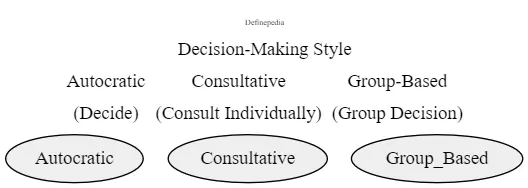Introduction
Good decision-making is vital because it influences the path of both our personal lives and professional careers. Basically effective decisions helps in positive outcomes, while poor choices can create harmful impacts. So when we talk to leadership, making good decisions is key to maintaining organizational stability, employee morale, and success.
The Vroom-Yetton model is a valuable tool for finding the complexities of decision-making in different situations. The Vroom theory Developed by Victor Vroom and Phillip Yetton. This model helps leaders determine the most appropriate decision-making style based on the context involved. It suggests that the best leadership style is dependent on the situation, rather than being a one-size-fits-all approach.
Here’s how you can introduce the Vroom-Yetton model in a conversational manner:

Imagine you’re a leader facing a critical decision that could significantly impact your team or even your whole organization. Now, think about the different ways you could approach this decision. Maybe you could make it alone, or maybe you’d need to gather input from your team. Would you go towards an authoritative style, or involving just a few key players, or opt for a more collaborative approach where everyone gets a say?
The Vroom-Yetton model is like a compass for such moments. It asks you to consider three key factors:
- Quality of the decision
- Potential for team collaboration
- Time constraints you’re working with
Based on your answers to these questions, the model guides you towards the most suitable decision-making style.
For example, if the decision is high-stakes and requires extensive resources, an authoritative approach. It might be warranted. But if the decision is about something that deeply affects your team. And there’s good time to discuss it, a collaborative process could yield the best results.
History of Vroom Yetton Model
The Vroom-Yetton model, also known as the Vroom-Yetton-Jago model, was first introduced by Victor Vroom and Philip Yetton in their 1973 book, “Leadership and Decision Making.” The model was later expanded upon by Vroom and Arthur Jago in their 1988 book, “The New Leadership.”
The original Vroom-Yetton model was developed as a tool for decision-making based on situational leadership. It helps leaders to choose the most effective management style for different decision situations. The model focuses on the fact that there is no one-size-fits-all approach to decision-making and that the style of leadership should be tailored to the specific circumstances.
The model was further refined and expanded upon in the 1988 book by Vroom and Jago. The newer version of the model incorporated additional questions and considerations, such as geographic location.
- It helps users to make more right decisions.
- It also introduced a mathematical relationship to assist in identifying the optimal decision-making process for a given situation.
Principles of Vroom Model

The core principle of the Vroom-Yetton-Jago model is that there is no “one-size-fits-all” approach to decision-making. Instead, the model focuses on the best decision-making approach and leadership style should be based on the specific circumstances of the situation.
The model takes into account three main factors that influence the decision-making process: decision quality, potential for collaboration, and time constraints.
- Decision Quality: This factor considers the importance of making a high-quality decision. It takes into account the potential consequences of the decision and the need to make the best choice. The higher the quality of the decision required, the more time and involvement from team members should be considered.
- Potential for Collaboration: This factor determines whether the decision can be made by the manager alone or if it requires collaboration and consultation with the team. Involving team members in the decision-making process can increase the quality of the decision and the commitment to its implementation.
- Time Constraints: This factor considers the time available to make the decision. The more time the manager has, the better the quality of the decision can be and the more team members can be involved in the process.
Based on these factors, the Vroom-Yetton-Jago model provides a set of eight questions that need to be asked in a specific sequence to determine the appropriate leadership style and level of participation in the decision-making process. These questions include:
- Quality Requirement (QR): How important is the quality of the decision?
- Commitment Requirement (CR): How important is team members’ commitment to the decision?
- Leaders Information (LI): Does the leader have sufficient information to make a high-quality decision on their own?
- Problem Structure (ST): Is the problem well-structured and defined?
- Commitment Probability (CP): If the leader makes the decision alone, is it reasonably certain that subordinates would be committed to it?
- Goal Congruence (GC): Do subordinates share the organizational goals related to the problem?
- Subordinate Conflict (CO): Is conflict among group members over preferred solutions likely?
- Subordinate Information (SI): Do team members have sufficient information to make a high-quality decision?
By answering these questions, the model helps leaders determine the appropriate level of participation and decision-making style, whether it be autocratic, consultative, or collaborative. It helps leaders towards the most effective means of reaching a decision based on the specific circumstances and factors involved.
Decision-Making Style

Autocratic (Decide)
The autocratic decision style is characterized by leaders making decisions alone without seeking input from others.
In this style, the leader relies on their own knowledge and expertise to make decisions. There are two variations of the autocratic style: AI and AII.
- Autocratic (AI): In this style, the leader makes the decision by themselves using existing information without any communication with the team.
This style is suitable when the leader believes they have sufficient information and expertise to make the decision independently.
- Autocratic (AII): In this style, the leader consults with team members to gather information but ultimately makes the decision by themselves without informing the group.
This style allows the leader to consider input from others but still maintains control over the decision-making process.
Consultative (Consult Individually):
The consultative decision style involves leaders seeking individual suggestions and opinions before making a decision.
This style promotes collaboration and involvement from team members, but the final decision is made by the leader. There are two variations of the consultative style: CI and CII.
- Consultative (CI): In this style, the leader consults with team members to get their opinions about the situation, but ultimately makes the decision themselves.
The leader considers the input from others but retains the authority to make the final decision.
- Consultative (CII): This style is similar to CI, but the leader not only seeks opinions and suggestions from team members but also considers their ideas and suggestions.
The leader is open to suggestions and ideas and aims to reach a decision that everyone agrees on.
Group-Based (Group Decision)
The group-based decision style involves leaders sharing the decision-making process with team members.
The leader supports the team in making the decision and finding an answer that everyone agrees on. There is one variation of the group-based style: GII.
- Group-Based (GII): In this style, the leader facilitates the decision-making process by involving the team members.
The leader discusses the problem and situation with the team as a group and seeks their ideas and suggestions through brainstorming.
The leader’s role is to facilitate and help the team members reach a unanimous decision. The decision accepted by the group is considered the final one.
The decision-making process can be influenced by factors such as the quality of the decision, commitment from team members, available information, problem structure, team support, and potential conflict.
Overall, the Vroom-Yetton-Jago model provides a systematic and practical framework for leaders to make effective decisions. It recognizes the importance of considering various factors and tailoring the leadership style accordingly. The model has been widely studied and applied in various fields, contributing to the understanding of leadership and decision-making processes.
So by applying the Vroom-Yetton model, leaders can make decisions that fit with their organization’s needs. So that every member feels valued in the process. This not only leads to better outcomes but also fosters a culture of trust and mutual respect within the team.
Was this helpful?
1 / 0